Introduction
Various countries have established strict regulations governing the distribution and storage temperatures to safeguard egg quality (Table 1; Chousalkar et al., 2018; Fikiin et al., 2020). In the United States, only washed eggs (WE) are permitted for distribution and must be stored and transported at or below 7.2°C (45°F) within 36 hours post-laying (FDA, 2023). According to the Canadian egg-handling guidelines for producers, eggs should be washed prior to distribution and stored at temperatures and RH levels not exceeding 10°C and 85% RH, respectively (CFIA, 2023b). In contrast, the European Union confines the washing of eggs to authorized member states for WE, with class A eggs not artificially refrigerated below 5°C (EC, 2017). Sell-by-dates are established at 30 days in the United States and 21 days in the European Union, whereas no specific period is set in Canada. The diversity in distribution regulations arises owing to the necessity of accommodating transportation distance and climate conditions inherent to each country (FAO, 2020). Therefore, there are limitations in applying these regulations to the egg industry in Korea.
| Nation | Distribution1) | Storage temperature | Sell-by-date |
|---|---|---|---|
| Korea | WE | 0°C–10°C | 45 days |
| UE | 1°C–35°C | ND | |
| United States | WE | Below 7.2°C | 30 days |
| Canada | WE | Below 10°C | ND |
| European Union | UE | Above 5°C | 21 days |
In Korea, a safety management standard was applied, including the egg washing process and distribution temperature, by amending the Livestock Products Sanitary Control Act (Table 1; MFDS, 2023b). According to the Ministry of Food and Drug Safety (MFDS), WE must be preserved and distributed at 0°C–10°C (MFDS, 2023d). Unwashed eggs (UE) are mandated to be distributed at 1°C–35°C and recommended to be distributed at 0°C–15°C when possible. However, refrigerated eggs must consistently adhere to refrigeration conditions. Complexity arises from the variance in stipulated storage temperatures based on washing status, refrigeration, and recommendations, leading to confusion during distribution. Moreover, the recommended sell-by-date for WE is 45 days, while a specific sell-by-date for UE has not been established.
Given the wide distribution temperature range of UE in Korea, these eggs are susceptible to exposure to various temperature fluctuations during the distribution process. Moreover, the amalgamation of storage temperature regulations coupled with the absence of an established sell-by-date can lead to confusion among egg producers and consumers. Regarding WE, although refrigeration regulations are enforced during distribution, sporadic exposure to improper temperatures is still expected (Lee and Hong, 2005; Lee et al., 2004). Without strict temperature management, WE can be mixed with eggs that are distributed at temperatures exceeding the regulated refrigeration temperature. Furthermore, the lack of explicit sell-by-date guidance for WE could potentially compromise safety and quality. Previous studies have examined quality alterations in both WE and UE under consistent temperature conditions (Jones et al., 2018; Lee and Hong, 2005; Liu et al., 2016). However, scientific data regarding quality changes under variable temperature storage remains insufficient, necessitating the establishment of precise sell-by-date guidance for effective safety and quality management.
Thus, the aim of this study was to develop appropriate temperature management practices in the actual distribution environment by assessing the quality of WE and UE under various storage scenarios. Moreover, we aimed to provide scientific evidence to support the development of sell-by-date guidance for eggs.
Materials and Methods
WE and UE were procured from four laying farms and one egg grading and packaging center in Korea. All eggs were obtained from laying hens accommodated within layer cages measuring 0.05 m2 per hen. Upon collection, the eggs were transported to the laboratory within 2 days post-laying and subsequently stored in incubators with preset experimental temperatures.
To assess the quality changes in WE and UE under varying storage temperatures, six scenarios were developed based on distribution temperature tracing data and interviews conducted with poultry farm owners and distributors (Fig. 1). Tracing data indicated that it typically took 4–5 days for eggs to arrive at retail stores after laying. This period was defined as the distribution period, and the period spanning from day 5–15 was the storage period for retail stores and consumers (data not shown). The selected storage temperatures included: 10°C, the upper limit of refrigeration temperature; 20°C, the highest observed distribution temperature during pre-investigation (data not shown); 30°C, the highest temperature recorded in Korea during the summer seasons of 2020–2022 (KMA, 2023); 35°C, the upper limit of distribution temperature for UE (MFDS, 2023d). Although WE should be distributed at 0°C–10°C, they were stored under the same conditions as UE to assess quality changes when WE were unintentionally mixed with UE. To effectively observe quality changes under severe storage conditions, average temperatures were not used. The scenario design included: scenario 1 (S1) and scenario 2 (S2) that simulated sporadic exposure to elevated temperatures during transit and subsequent retail storage at 10°C or 20°C, respectively. Scenario 3 (S3) and scenario 4 (S4) simulating continuous exposure to heightened temperatures during transportation and subsequent retail storage at 10°C or 20°C, respectively. Lastly, scenario 5 (S5) and scenario 6 (S6) depicting eggs being distributed under ambient temperature conditions and stored outdoors in elevated temperatures (30°C or 35°C), akin to retail environments.
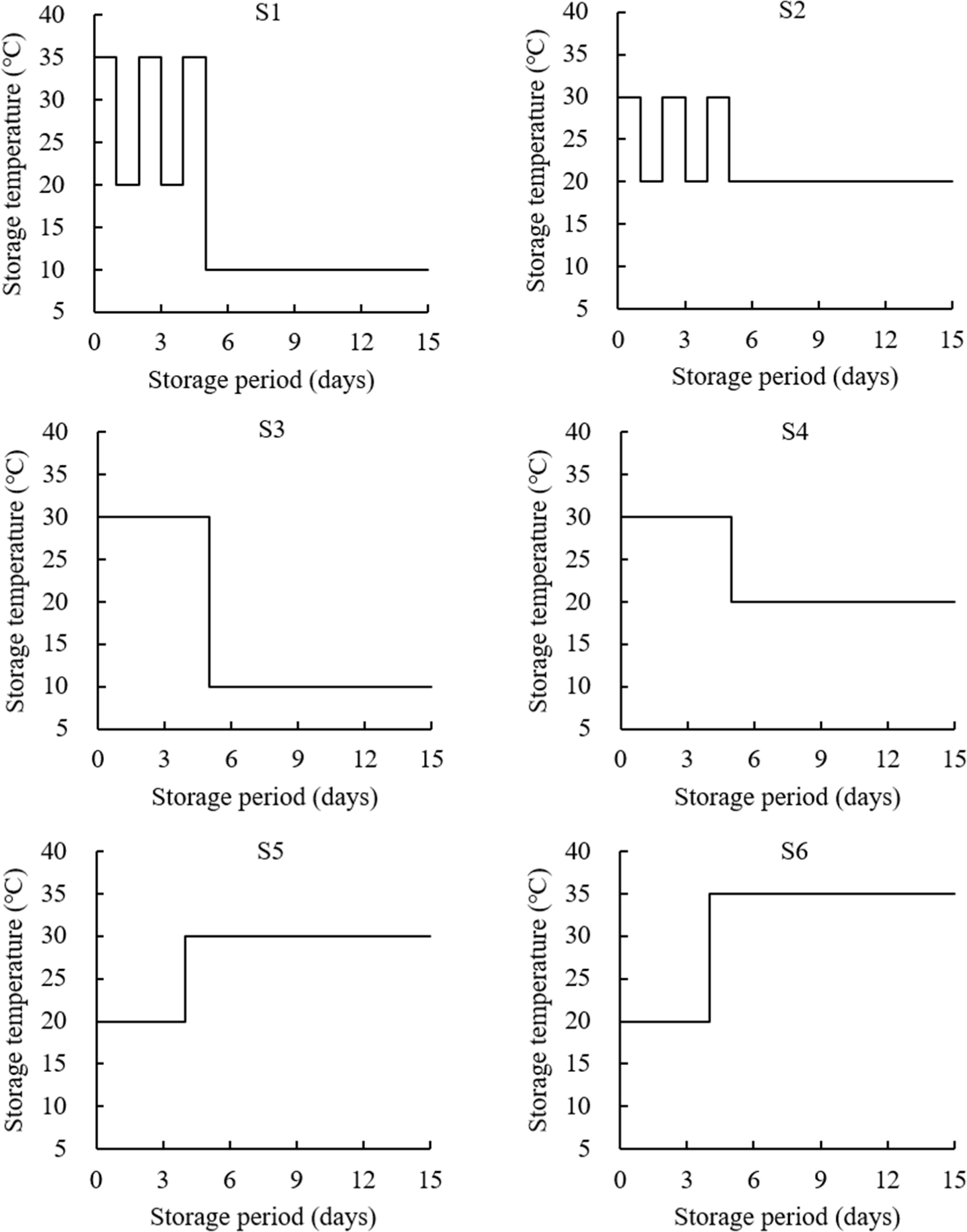
To observe the period for maintaining the appropriate quality of WE above regulated temperatures, WE were stored for up to 82 days at 15°C, 20°C, 25°C, 30°C, and 35°C. Similarly, to develop sell-by-date guidance for UE, they were stored for up to 50 days at 20°C, 25°C, 30°C, and 35°C. In Korea, more than 85% of eggs are distributed as grade 1+, with over 70% and 90% graded as class A and B, respectively (KIAPQE, 2023; MAFRA, 2020). Therefore, for both WE and UE, the appropriate sell-by-date was determined based on the period of maintaining class B quality.
The Haugh unit (HU) is a commonly used measurement in the egg industry in Korea and the United States (MAFRA, 2020; USDA, 2000). In Korea, quality grades are determined based on HU scores. A score above 72 qualifies as class A, 60–72 for class B, 40–60 for class C, and below 40 for class D. Each egg was weighed (g) and broken onto a flat surface to measure the height of the thick albumen (mm) using a tripod micrometer (Digital Haugh Tester; Orka Food Technology, West Bountiful, UT, USA). Subsequently, the HU was calculated using the following Eq. (1):
Where H is the height of the thick albumen (mm), and W is the weight of the egg (g).
To assess the quality of the yolk, the yolk index (YI) was measured following a method described by Kim et al. (2015) with minor modifications. The width of the yolk (mm) was measured using vernier calipers (CD-30PSX; Takatsu, Mitutoyo, Kawasaki, Japan), and the height of the yolk (mm) was measured using the same tripod micrometer (Digital Haugh Tester; Orka Food Technology). Subsequently, the YI was calculated using the following Eq. (2):
Subsequently, the albumen from three eggs was pooled and homogenized, and the pH of the albumen was measured using a pH meter (S210; Mettler Toledo, Greifensee, Zürich, Switzerland).
Each of the three eggs per storage condition and sampling time was tested for quality assessment. Each egg underwent multiple measurements, including HU, YI, and albumen pH. The collected data were analyzed using the SPSS software package (SPSS 26.0; IBM, New York, NY, USA). Statistical differences in HU score and YI were determined using one-way ANOVA with Duncan’s multiple range test (p<0.05).
Results and Discussion
Changes in the HU scores of WE and UE under different storage scenarios are shown in Figs. 2 and 3, respectively. The HU score decreased significantly on day 3 by 10.58%–22.02% across all storage scenarios, and a further significant decline was observed between day 9 and 15 as the storage temperature increased after day 5. For S1 and S3, following a storage temperature changed to 10°C, the HU scores were 73.16–82.05 for WE and 85.72–94.60 for UE until day 15, with no significant difference between S1 and S3. For S2, the HU score for WE and UE significantly decreased until day 9 to 73.92 and 83.16, respectively, remaining stable until day 15. Under S4 conditions, no significant decrease was observed after lowering the temperature to 20°C, with HU scores of 72.13–79.06 for WE and at 86.78–94.92 for UE during day 3–15. The HU score decreases observed in S2 and S4 did not show a significant difference during the storage period. Under S5 and S6 conditions, HU scores decreased rapidly and showed significantly lower scores of 52.16–65.68 for WE and 77.67–78.50 for UE on day 15, compared to those under the other tested scenarios. The HU score decrease patterns were similar between WE and UE.
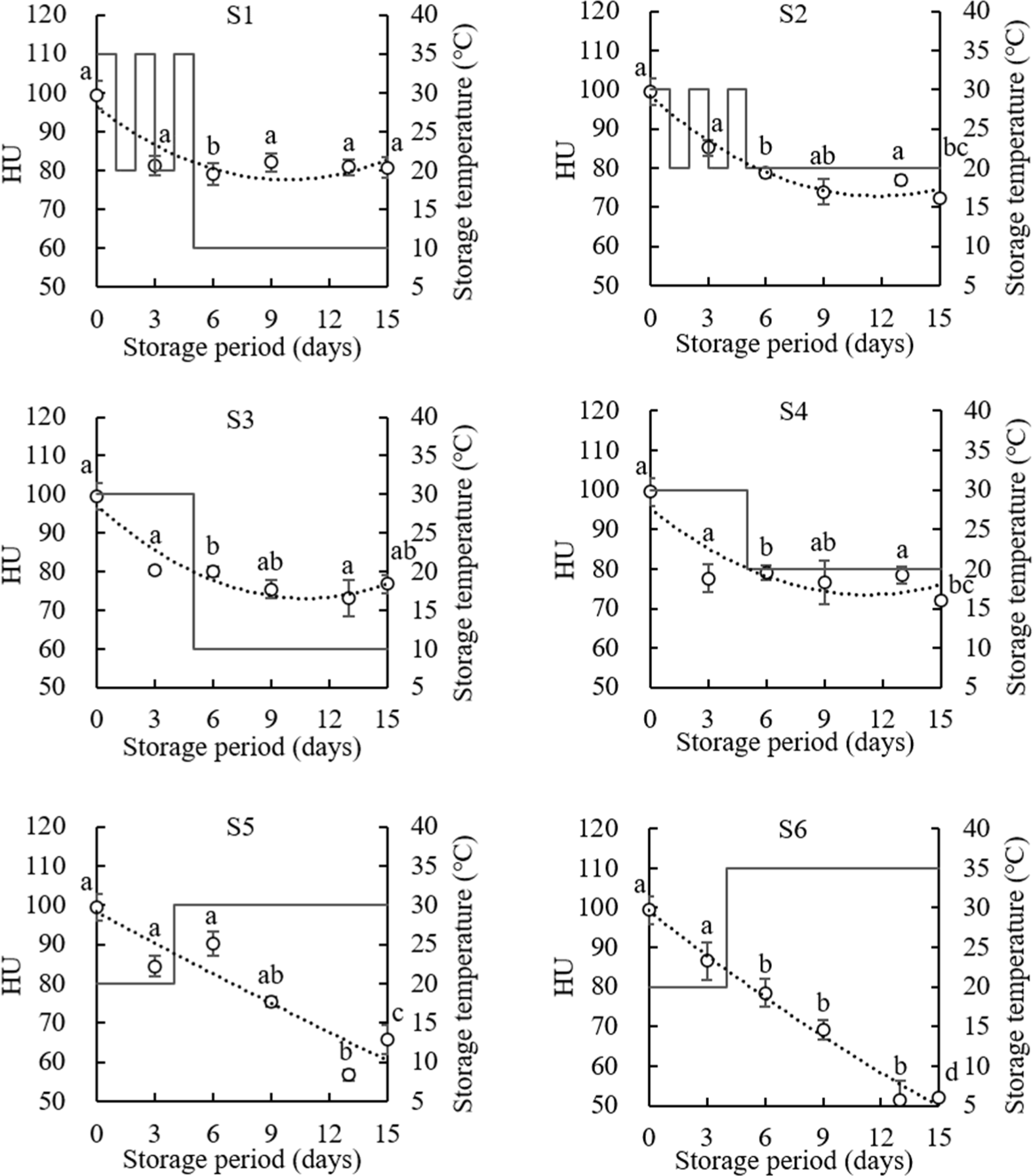
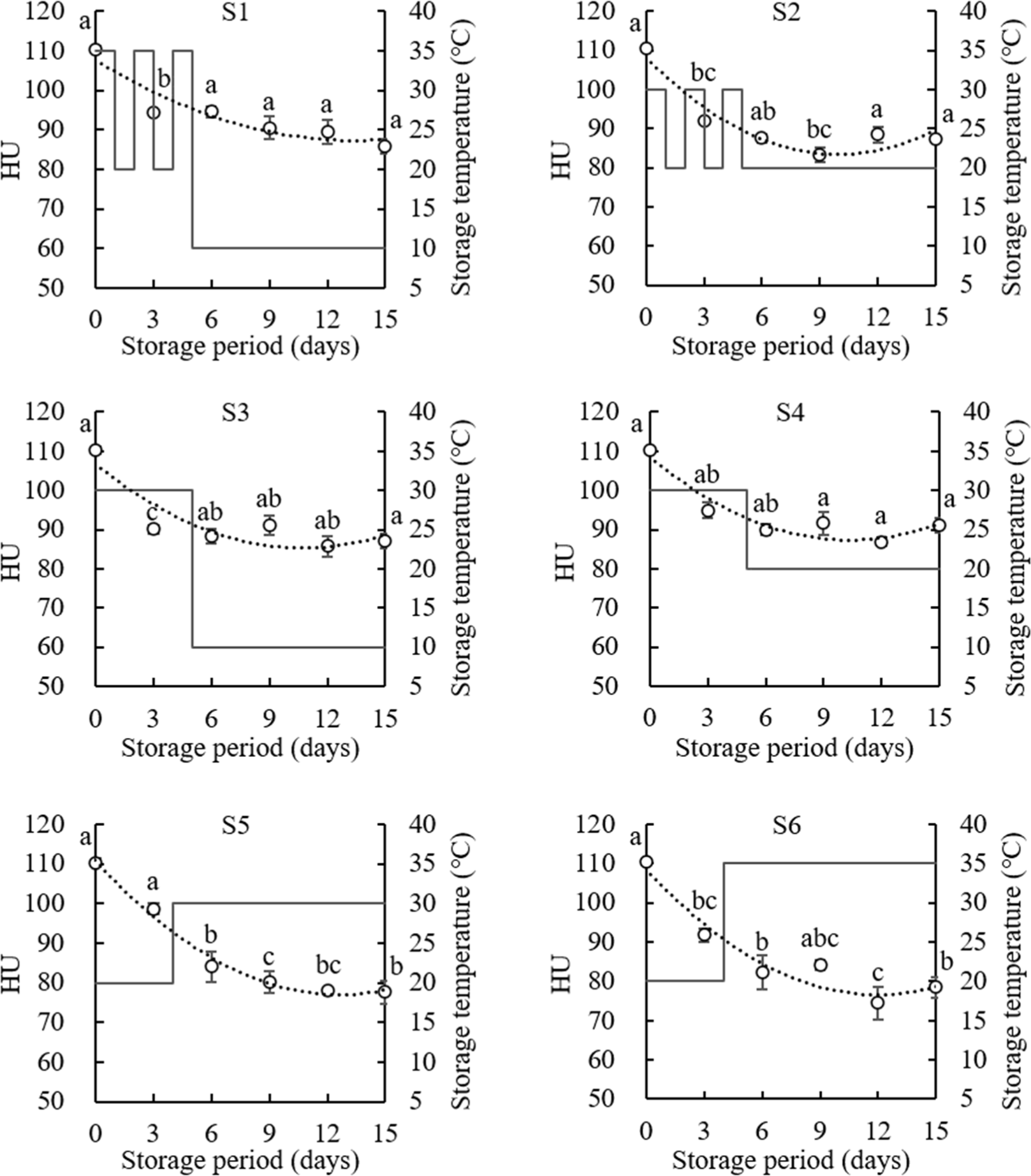
Despite subjecting the eggs to fluctuating or constant temperatures up to 35°C until day 5, the storage temperature during days 5–15 (the retail stage) significantly affected the HU scores of both WE and UE. The decrease in HU score was closely associated with the increase in albumen pH, attributed to the release of carbon dioxide through the eggshell pores (Huopalahti et al., 2007). Moreover, the increase in albumen pH is positively correlated with storage temperature (BIOHAZ, 2014). Samli et al. (2005) reported a significant decrease in the HU score of UE by 16.53%, 41.18%, and 55.60% after 10 days of storage at 5°C, 21°C, and 29°C, respectively. Moreover, they found that the albumen pH also increased significantly from 7.47 to 8.26, 8.94, and 9.11 on day 10 at these respective temperatures. Furthermore, Liu et al. (2016) reported a significant correlation coefficient between HU score of WE and albumen pH (p<0.05).
Across all tested storage scenarios, the pH of the albumen of both WE (Fig. 4) and UE (Fig. 5) increased rapidly from approximately 8.20 to 9.34–9.47 by day 6. Furthermore, this upward pH trajectory persisted, with values ranging from 9.15–9.69 on day 15. Notably, this increase corresponded to the escalation in storage temperature from 10°C to 35°C during days 5–15.
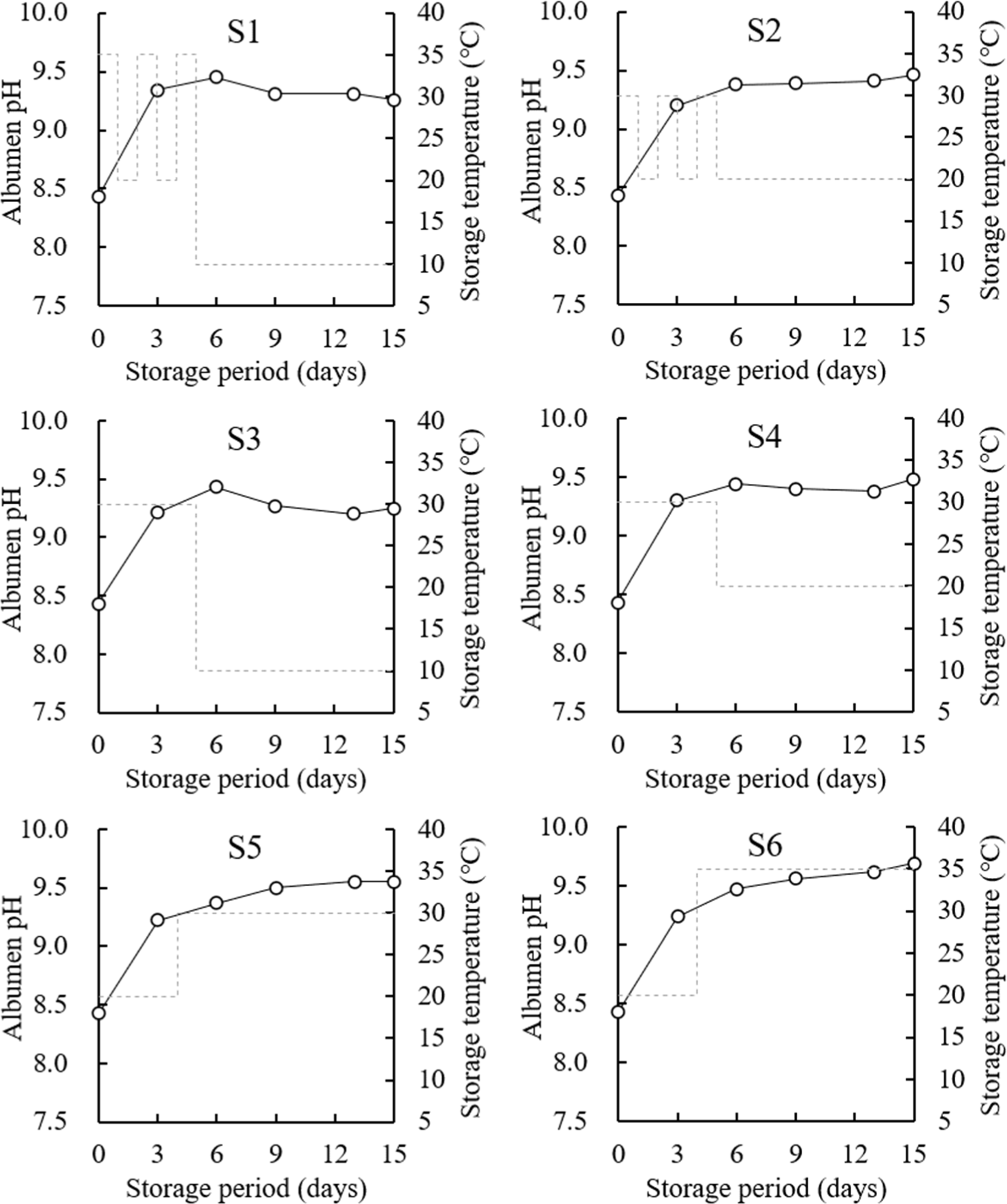
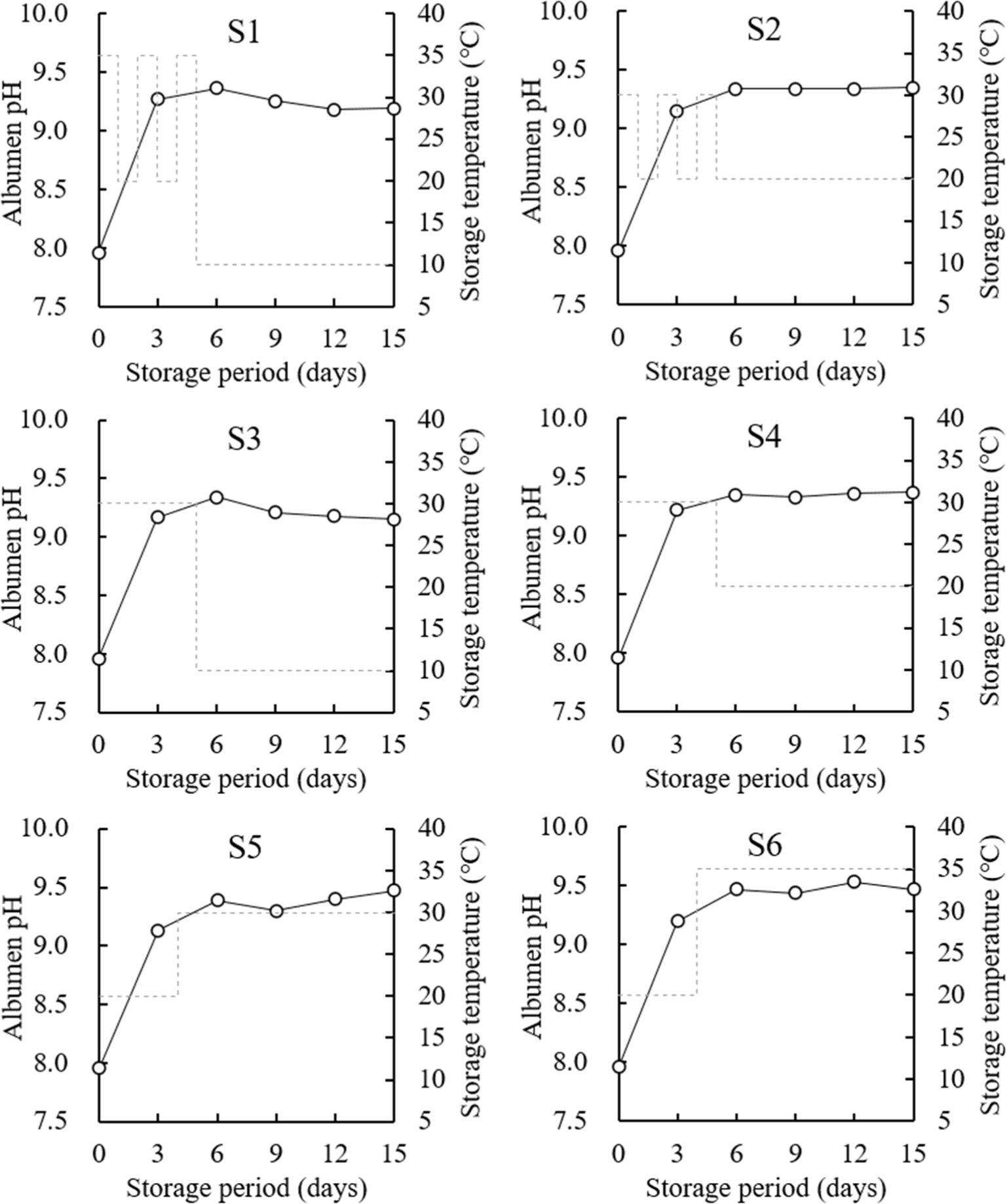
Previous studies have indicated that albumen pH increases sharply from approximately 8.0 to 9.0 within 5 days and maintains the level during storage (Jin et al., 2011; Samli et al., 2005). Additionally, Akyurek and Agma Okur (2009) observed that when UE from 22-week-old hens were stored at 4°C and 20°C, there was no significant difference between albumen pH and HU scores on day 3, but from day 7 onward, significantly higher values were recorded at 20°C. During the rapid increase in albumen pH, the temperature change of 20°C–35°C may not affect the HU score. However, the storage temperature following albumen pH stabilization may have a significant effect on the HU score. These findings highlight the importance of refrigerating both WE and UE starting from the retail stage and present the first scientific validation for temperature management practices within the actual distribution stage of eggs.
The decreases in the YI across different storage scenarios correlated with the decrease pattern of the HU scores (Figs. 6 and 7). In all scenarios, the YI decreased significantly on day 3 by 7.90%–26.59% and continued to exhibit a significant decrease on day 15, particularly as the storage temperature increased after day 5. For S1 and S3, after the storage temperature was changed to 10°C, the YI was maintained at 0.31–0.35 for WE and 0.38–0.45 for UE until day 15. There was no significant difference between S1 and S3 during the storage period. Similarly, under S2 and S4 conditions, the YI remained constant after changing the temperature to 20°C, ranging from 0.26–0.36 for WE and 0.37–0.41 for UE until day 15. In contrast, after changing the temperature from 20°C to 30°C (S5), the YI of WE and UE significantly decreased on day fifteen to 0.19 and 0.28, respectively, which were significantly lower compared to those under S1–S4 conditions. The most significant decrease in YI on day 15 was observed under S6 conditions, with values of 0.13 and 0.19 for WE and UE, respectively. The YI decrease patterns were similar between WE and UE.
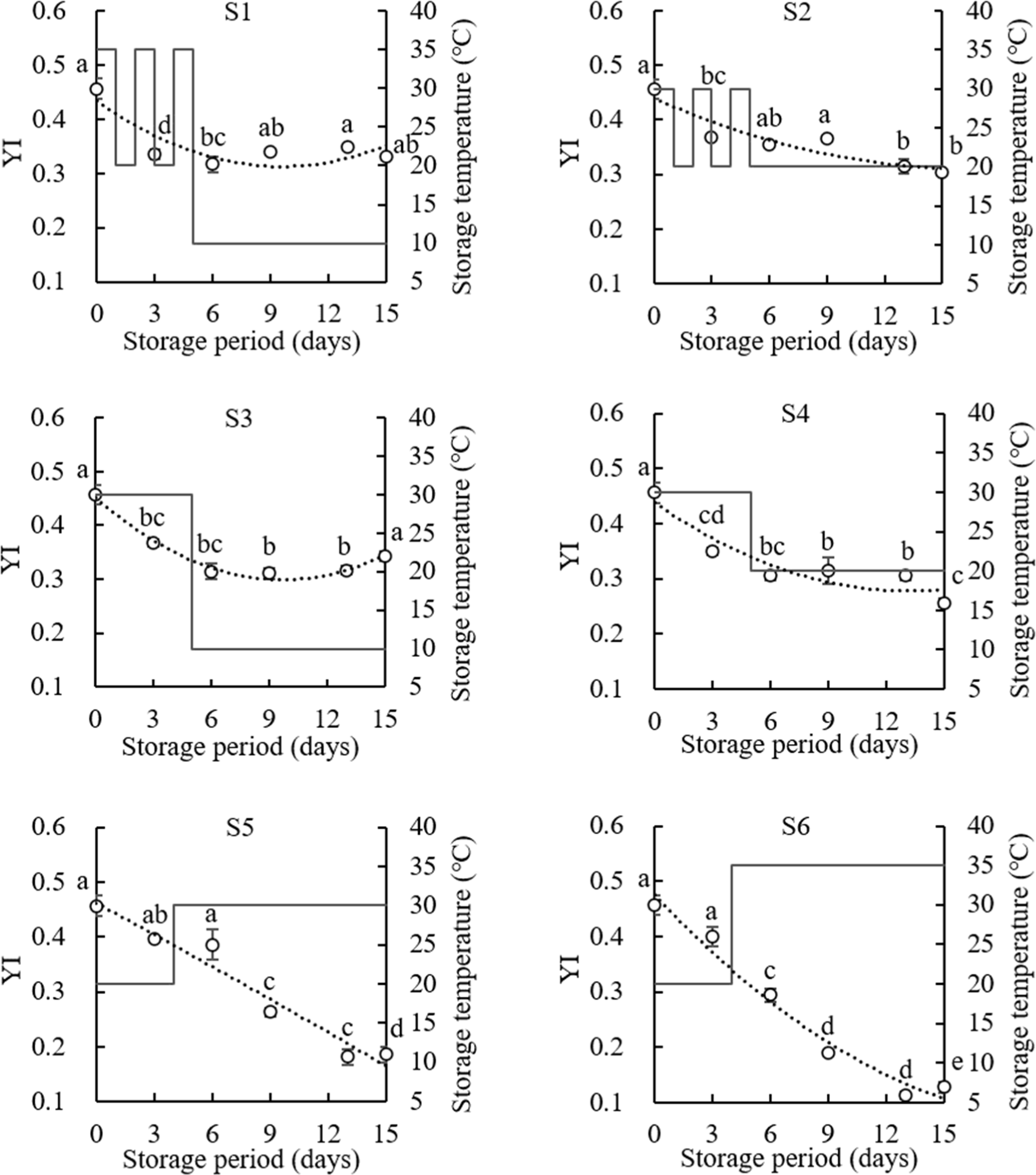
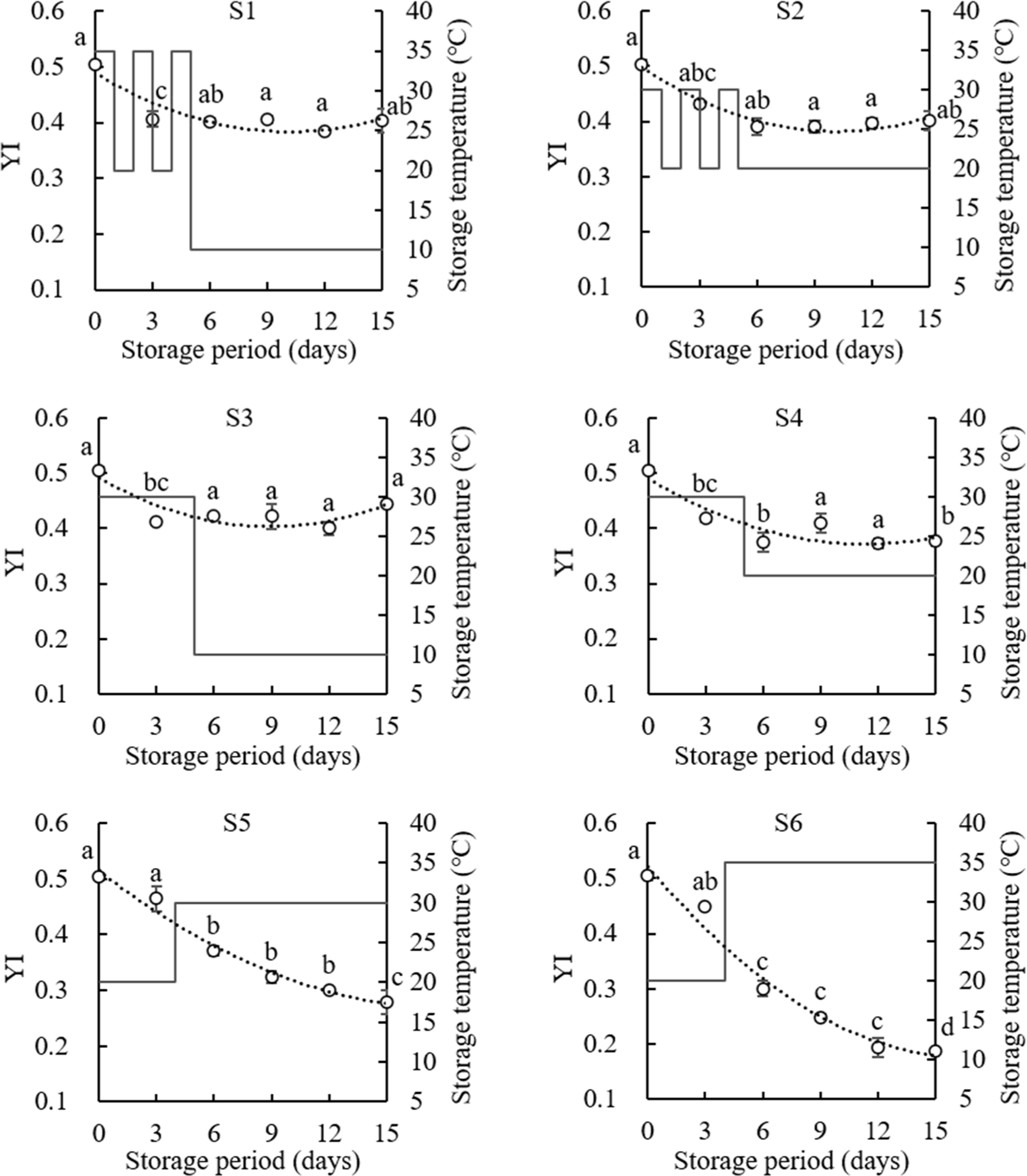
The storage temperature after days 4–5 significantly affected the YI, despite subjecting the eggs to fluctuating or constant temperatures up to 35°C. The decrease in YI can be attributed to the movement of moisture from the albumen into the yolk through the vitelline membrane, which is a fibrous glycoprotein that surrounds the yolk (Kumari et al., 2020; Stadelman and Cotterill, 2007). This moisture movement leads to an increase in yolk volume and a reduction in the strength of the vitelline membrane. Consequently, the diameter of the yolk widens and becomes flatter, resulting in a decrease in YI. Albumen liquefaction-induced moisture generation due to elevated albumen pH, could further impact YI decline (Guedes et al., 2016). Akyurek and Agma Okur (2009) demonstrated that UE stored at 4°C and 20°C exhibited YI values of 0.46 and 0.40, along with albumen pH of 8.88 and 9.22, respectively, highlighting significant differences in both indicators. In the study conducted by Liu et al. (2016), an inverse correlation coefficient relationship was established between YI and albumen pH of WE (p<0.01). Similar to the HU results, YI remained unaffected by temperature changes ranging from 20°C to 35°C during the rapid increase in albumen pH. These results indicate that refrigerating eggs from the retail stage onward can maintain not only albumen and yolk quality.
To observe the maintenance period of class B quality for WE and develop sell-by-date guidance for UE, both WE and UE were stored at a constant temperature of up to 35°C. At 15°C, WE maintained class B quality for 82 days. However, this period decreased from 42 to 9 days as the storage temperature increased from 20°C to 35°C (Fig. 8A). During the period in which WE maintained class B quality, the average YI significantly decreased from 0.46 to 0.23, showing a similar decrease pattern as observed in the HU score (Fig. 8C).
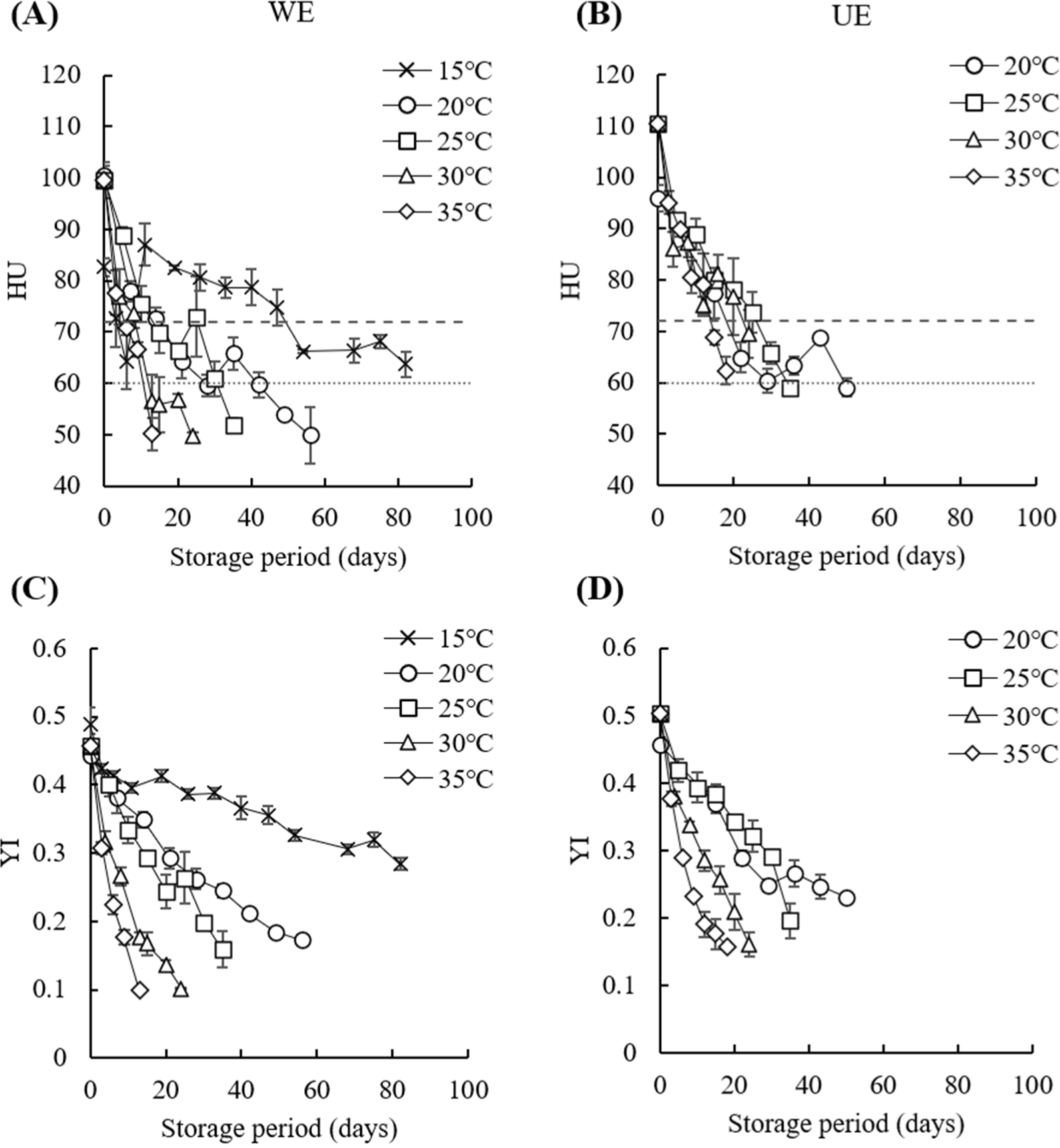
At 15°C, WE maintained class B quality for an additional 37 days beyond the recommended sell-by-date of 45 days in Korea (Table 1; MFDS, 2023c). These results suggest that WE can maintain class B quality for longer than 82 days at or below 10°C, which is the regulated storage temperature for WE. In the United States, WE should be sold within 30 days at or below 7.2°C from the day of packaging (USDA, 2012). Canada does not have a mandated sell-by-date, but egg producers are required to establish appropriate durable life dates (CFIA, 2023a).
The class B quality maintenance period of UE was 24 and 18 days at 30°C and 35°C, respectively, and increased as the storage temperature lowered (Fig. 8B). Moreover, the average YI of UE decreased significantly from 0.49 to 0.21 until the period in which class B quality was maintained (Fig. 8D), following a similar decrease pattern as observed in HU.
For UE, the class B quality maintenance period was approximately 20 days at 30°C and 35°C, which is 3 and 2 times longer than that of WE, respectively. The shorter quality retention period of WE was attributed to the declined cuticle coverage caused by the washing process (BIOHAZ, 2014). Liu et al. (2016) reported that the loss of the cuticle exposes pores, facilitating moisture diffusion from the albumen and resulting in quality deterioration. Additionally, strong correlations were observed between cuticle coverage and egg quality parameters, including HU, albumen pH, and YI (p<0.01).
There are currently no specific sell-by-date regulations for UE in Korea. In the European Union, UE must reach consumers within 21 days of laying at ambient temperature (EC, 2023). Throughout Europe, the highest temperature observed in summer was 30.5°C between 1981 and 2010 (EEA, 2023). This is similar to the highest temperature observed in summer in Korea. Given this similarity, it is necessary to develop UE sell-by-date guidance, informed by European Union regulations. Egg quality deterioration signifies a decline in physicochemical defense mechanisms, increasing susceptibility to bacterial spoilage (BIOHAZ, 2014). The absence of sell-by-date guidance for UE contributes to an elevated risk of foodborne illness, and developing the guidance is essential to mitigate this risk. Based on Korean climate conditions (KMA, 2023), these results suggest that if WE and UE are not refrigerated in spring and autumn, consuming them within 30 days is recommended. However, in summer, it is advisable to consume WE within 8 days and UE within 24 days.
In this study, differences in initial quality were observed between WE and UE. Previous studies reported that initial egg quality was influenced by various factors, including feed, age of layers, and housing systems (Dikmen et al., 2017; Ray et al., 2022). In Korea, information about the housing system should be labelled on the eggshell, but other factors are not indicated (MFDS, 2023a). Thus, in this study, only the housing system was controlled to focus on quality changes in commonly distributed eggs, and these differences resulted from uncontrolled factors. This study is the first to delineate appropriate egg-handling practices based on the actual distribution environment in Korea. While this study assessed the changes in egg quality under storage conditions, it did not evaluate the survival characteristics of pathogens. Therefore, further investigations, encompassing both quality measurements and bacteria survival evaluations, are required.
Conclusion
This study aimed to provide appropriate egg-handling practices during distribution. Refrigerating eggs from the retail stage onward resulted in significantly higher egg quality, despite temperature fluctuations or continuous storage up to 35°C during distribution. Moreover, WE retained class B quality for an additional 37 days beyond the recommended sell-by date of 45 days at 15°C, which is above the regulated storage temperature. However, UE maintained class B quality for approximately 20 days at 30°C–35°C, emphasizing the need for UE-specific sell-by-date guidelines, aligning with EU regulations. By delivering evidence-based insights, this study paves the way for effective temperature management strategies in the egg distribution landscape.













